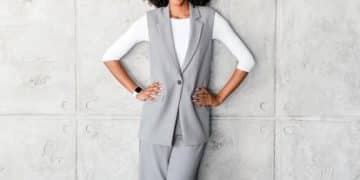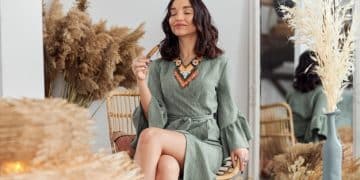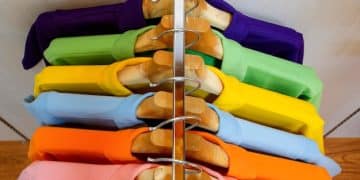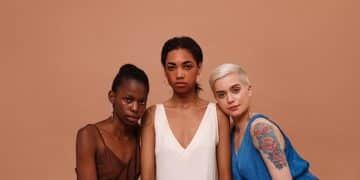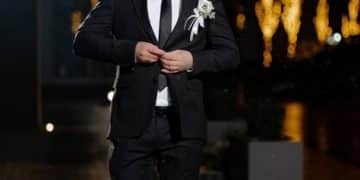Confidence Through Clothing: Dress for Success & Feel Your Best

Anúncios
Achieving confidence through clothing involves strategically selecting garments that align with your personal style, enhance your appearance, and positively influence your psychological state, leading to improved self-esteem and better performance in various life contexts.
Have you ever noticed how some days, just putting on a particular outfit can completely shift your mood and mindset? It’s not just your imagination. The connection between what we wear and how we feel—our sense of self-assurance and capability—is profound. Exploring confidence through clothing isn’t about chasing fleeting trends or spending a fortune; it’s about understanding how strategic wardrobe choices can empower you to dress for success, genuinely feeling your best from the inside out.
Anúncios
The Psychology Behind Dressing for Success
The saying “dress for success” is more than just a cliché; it’s rooted in psychological principles. Our clothing acts as a form of non-verbal communication, influencing not only how others perceive us but, more critically, how we perceive ourselves. This phenomenon is often referred to as “enclothed cognition.” It describes the systematic influence that clothes have on the wearer’s psychological processes.
When you choose an outfit, you are essentially selecting a costume for the role you intend to play. If that role is one of an authoritative professional, a creative innovator, or a relaxed individual, your clothes can help you embody that character. For instance, studies have shown that subjects wearing a lab coat performed better on attention-related tasks than those wearing their regular clothes, particularly if they believed the coat belonged to a doctor. This suggests that the symbolic meaning of attire can activate associated cognitive processes.
Anúncios
Enclothed Cognition: More Than Just Looking Good
The concept of enclothed cognition extends beyond mere appearance. It delves into the neurological and psychological shifts that occur when we put on certain types of clothing. It posits that there are two necessary components: the symbolic meaning of the clothes and the physical experience of wearing them. When these two align, the effect on our cognition and behavior can be significant.
- 🚀 Enhanced Performance: Dressing for a specific task can prime your brain for that activity, potentially improving focus and effectiveness.
- 🎯 Increased Self-Esteem: Feeling good about what you wear often translates into higher self-worth and a more positive self-image.
- 🧠 Improved Mood: Certain colors, textures, and styles can evoke positive emotions, leading to a brighter outlook.
Consider the classic power suit. It’s not just about looking sharp; it’s about feeling powerful, competent, and in control. The structure of the fabric, the tailored fit, and the associations with leadership roles can all contribute to a heightened sense of self-efficacy. This internal shift is crucial for fostering genuine confidence. It moves beyond superficiality to a deeper, more embodied sense of capability.
Ultimately, understanding the psychology behind dressing for success allows us to make more intentional choices about our wardrobe. It highlights that clothing is not just about covering our bodies; it’s a powerful tool for self-expression, self-regulation, and self-enhancement. By harnessing this power, we can consciously cultivate the mindset needed to achieve our goals and feel our absolute best.
Defining Your Personal Style: A Foundation for Confidence
Before you can truly dress for success, you need to understand what “success” means for your personal aesthetic and goals. Defining your personal style is not about conforming to external expectations, but about discovering what genuinely resonates with you and makes you feel authentic. It’s a journey of self-discovery that influences how you present yourself to the world.
Your personal style is a reflection of your personality, values, and aspirations. It’s a visual language that communicates who you are without uttering a single word. When your external appearance aligns with your internal identity, it creates a powerful sense of coherence, which is a cornerstone of true confidence. This alignment eliminates the feeling of “playing a part” and replaces it with genuine self-expression.
Exploring Your Style Identity
Embarking on the journey of defining your personal style requires introspection and experimentation. It involves figuring out what colors, silhouettes, fabrics, and patterns make you feel most comfortable, attractive, and empowered. It is an evolving process, as your style grows and changes with you.
- 🌟 Inspiration Gathering: Look for inspiration from fashion magazines, social media, historical figures, or even art. Identify elements that consistently draw your eye.
- 🔄 Wardrobe Audit: Go through your current wardrobe. What do you love wearing? What makes you feel uncomfortable or uninspired? Pay attention to the common threads among your favorite pieces.
- 📝 Keyword Identification: Describe your ideal style in 3-5 keywords. Are you classic, minimalist, bohemian, edgy, artistic, sporty? These words will serve as your guiding principles.
Once you have a clearer idea of your style identity, you can begin to curate your wardrobe more intentionally. This doesn’t mean buying a whole new set of clothes. Instead, it involves making thoughtful purchases that fit within your identified style, ensuring each piece adds value and versatility. Building a cohesive wardrobe that reflects your true self is incredibly liberating. It removes the stress of deciding what to wear, as every item is a potential confidence booster.
Remember, personal style is not static. It evolves as you do. Embrace the process of discovery, allow yourself to experiment, and don’t be afraid to break traditional “rules” if they don’t align with who you are. The most authentic and confident dressers are those who truly own their unique aesthetic, making it an extension of their personality rather than a costume.
Building a Versatile Wardrobe for Any Occasion
A truly confident individual is someone who feels prepared for anything, and that extends to their wardrobe. Building a versatile wardrobe is not about owning countless items, but about curating a collection of well-chosen pieces that can be mixed and matched to create appropriate and stylish outfits for a variety of occasions. This strategic approach ensures you always have something suitable to wear, reducing decision fatigue and increasing your overall sense of preparedness.
Functionality and adaptability are key. A versatile wardrobe often hinges on classic, good-quality pieces that transcend fleeting trends. These foundational items can then be updated or personalized with accessories or more trendy seasonal pieces. The goal is to maximize the utility of each garment, allowing you to transition seamlessly from a professional meeting to a casual outing, or from a formal event to a relaxed weekend.
Essential Components of a Flexible Wardrobe
Creating a versatile wardrobe begins with identifying your lifestyle needs and then investing in key pieces that cater to them. Think about the dominant activities in your life—work, social events, leisure—and build around those requirements.
- 👖 Quality Basics: Invest in high-quality basics like well-fitting jeans, neutral-colored trousers, versatile skirts, and plain t-shirts or tops. These form the building blocks of countless outfits.
- 🧥 Layering Pieces: Blazers, cardigans, and versatile jackets are excellent for adapting outfits to different temperatures and levels of formality, adding polish or a relaxed vibe as needed.
- 👟 Multi-purpose Footwear: A selection of comfortable yet stylish shoes, such as classic pumps, versatile sneakers, and ankle boots, can elevate or casualize an outfit instantly.

The beauty of a versatile wardrobe lies in its ability to be transformed with minimal effort. A simple black dress, for example, can be styled for a formal event with heels and statement jewelry, or dressed down for a casual brunch with sneakers and a denim jacket. This adaptability not only saves money but also fosters creativity in your dressing, allowing you to discover new combinations and expressions of your style.
Furthermore, having a versatile wardrobe reduces stress. No more “what to wear” crises before important events. Instead, you’ll have a collection of reliable options that make you feel confident and appropriate, no matter the situation. This peace of mind significantly contributes to your overall well-being and sense of self-assurance.
The Power of Fit and Fabric: Elevating Your Look
While style and versatility are crucial, the true secret to elevated dressing and enhancing your confidence lies in the details: the fit and fabric of your clothing. No matter how expensive or trendy an item might be, if it doesn’t fit well or is made from a poor-quality fabric, it will detract from your overall appearance and, by extension, your confidence. Conversely, even a simple outfit can look incredibly chic and put-together when these two elements are perfectly executed.
A well-fitting garment flatters your body shape, creating clean lines and a polished silhouette. It moves with you, providing comfort and ease, rather than constricting or bagging. Custom tailoring can make an enormous difference, transforming off-the-rack items into bespoke pieces that seem made just for you. This attention to fit not only makes you look better but also signals to yourself and others that you value precision and care in your presentation.
Understanding the Impact of Fit and Fabric
Choosing the right fit is arguably more important than adhering to specific trends. A beautifully tailored piece can make you feel more poised and capable. The same applies to fabric—its drape, texture, and how it feels against your skin can significantly impact your comfort and the perceived quality of your outfit.
- ✂️ Tailoring Is Key: Even minor alterations, like hemming trousers or taking in a waist, can dramatically improve how a garment looks and feels on you.
- ☁️ Consider Fabric Properties: Understand how different fabrics drape, breathe, and wrinkle. Natural fibers like cotton, wool, silk, and linen often offer better comfort and a more luxurious feel than many synthetics.
- ✨ Embrace Comfort: Clothes that are uncomfortable or ill-fitting are distracting. When you’re comfortable, you’re better able to focus on your tasks and interact confidently with others.
The right fabric choices also play a role in how an outfit feels against your skin, which directly impacts your comfort and overall mood. A soft cashmere sweater can evoke feelings of warmth and luxury, while a crisp cotton shirt can make you feel sharp and professional. When you are physically comfortable and your clothes feel good, it’s easier to project an air of confidence.
Investing in quality fabrics and paying attention to fit might seem like small details, but they collectively contribute to a powerful overall effect. They elevate your entire look, conveying a sense of sophistication and thoughtfulness. More importantly, when your clothes feel good on you and look great, you’re naturally more inclined to carry yourself with poise and self-assurance.
Color and Pattern: Expressing Your Personality and Mood
Beyond fit and fabric, color and pattern are powerful tools in your wardrobe arsenal, capable of expressing your personality, influencing your mood, and even shaping how others perceive you. These elements add depth and dynamism to your outfits, allowing you to communicate nuances about your disposition, creativity, and professionalism without uttering a single word. Strategic use of color and pattern is a hallmark of truly confident dressers.
Colors evoke different emotions and associations. For example, blue is often linked with trust and stability, red with passion and power, and green with nature and tranquility. Understanding the psychology of color can help you choose shades that align with the message you want to convey or the feeling you want to cultivate. Patterns, too, carry their own symbolism, from the structured professionalism of pinstripes to the playful charm of polka dots.
Leveraging Color and Pattern for Impact
To effectively use color and pattern, consider your personal preferences, the context of the occasion, and the message you wish to send. It’s not about wearing every color or pattern, but about making deliberate choices that enhance your overall presentation and boost your inner feeling.
- 🌈 Personal Color Palette: Discovering which colors flatter your skin tone, hair color, and eye color can make a significant difference. These are often referred to as your “power colors.”
- 🎨 Strategic Accents: If bold colors or patterns feel intimidating, start by incorporating them as accents through accessories like scarves, ties, or handbags.
- ⚖️ Balancing Acts: When mixing patterns, ensure there’s a unifying element, such as a shared color, or vary the scale of the patterns to create visual harmony rather than chaos.
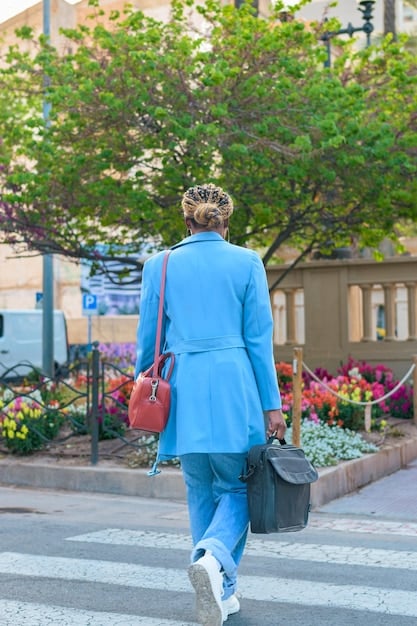
The right color can elevate your complexion, make your eyes sparkle, and generally make you appear more vibrant and healthy. When you wear colors that truly suit you, you receive subtle positive feedback, both internally and externally, which further reinforces your confidence. Similarly, choosing patterns that align with your aesthetic can add an element of intrigue and personal flair to your ensemble.
Ultimately, playing with color and pattern is a joyful aspect of dressing. It allows for creative expression and ensures your wardrobe is never boring. By understanding their impact and incorporating them thoughtfully, you can craft outfits that not only look good but also genuinely make you feel empowered, adding another layer to the concept of dressing with purpose and confidence.
Accessorizing Thoughtfully: The Finishing Touches
Accessories are often considered the unsung heroes of any outfit, serving as the finishing touches that can elevate a look from ordinary to extraordinary. Far beyond mere adornment, thoughtfully chosen accessories act as powerful statements, reflecting your personality, enhancing your style, and conveying attention to detail. They can transform the same basic outfit to suit different occasions or moods, making them indispensable for anyone looking to cultivate confidence through clothing.
From the subtle gleam of a watch to the bold statement of a necklace, accessories offer an opportunity to personalize your ensemble. They allow you to add pops of color, texture, and visual interest, refining your overall appearance. More importantly, selecting and pairing accessories thoughtfully demonstrates a level of intentionality and completeness that contributes significantly to a polished and confident presentation. It’s about creating a cohesive narrative with your clothing.
The Art of Accessorizing for Impact
Effective accessorizing is an art that balances personal expression with appropriateness for the occasion. It’s about choosing pieces that complement your outfit without overwhelming it, creating a harmonious and impactful look. Small details can often make the biggest difference.
- 🕰️ Quality Over Quantity: Invest in a few high-quality, classic accessories that can stand the test of time and complement multiple outfits. A good watch, a timeless handbag, or elegant earrings are always valuable.
- 🌟 Personal Touches: Use accessories to showcase your unique personality and interests. A quirky pin, a vintage brooch, or a handmade piece of jewelry can tell a story about you.
- 🎯 Purposeful Selection: Each accessory should serve a purpose, whether it’s functional (like a belt ensuring a good fit) or purely aesthetic (adding sparkle or color). Avoid clutter and choose pieces that enhance, not distract.
Accessories also play a crucial role in creating versatility within your existing wardrobe. A simple shift dress can go from day to evening with a change of shoes, jewelry, and a handbag. A plain suit can be given a completely different character with a bold tie and pocket square, or with a delicate scarf and statement earrings. This flexibility means you don’t need a vast wardrobe to have a diverse range of looks.
Ultimately, thoughtful accessorizing is about attention to detail. It shows that you care about your presentation and have put thought into your appearance. This meticulousness not only makes you look more put-together and capable but also reinforces your inner sense of confidence. When every element of your outfit is intentional, you carry yourself with greater assurance, projecting an image of quiet competence and refined style.
Mindset and Maintenance: Sustaining Your Confident Style
Achieving confidence through clothing is not just about what you wear, but also about the mindset with which you approach your wardrobe and the care you put into maintaining it. A confident style is sustainable; it’s not a one-off event but a continuous process nourished by positive self-perception and practical habits. Your mindset dictates your relationship with your clothes, while proper maintenance ensures your garments always look their best, allowing you to feel your best day after day.
The mindset component involves embracing authenticity and understanding that true style comes from within. It’s about dressing for yourself first, rather than solely to impress others. When you wear clothes that genuinely make you feel comfortable and joyful, that inner alignment radiates outwards. This self-acceptance is a powerful antidote to trends that don’t feel right or societal pressures that try to dictate your appearance.
Practices for a Confident and Sustainable Wardrobe
Sustaining your confident style involves both internal work—cultivating a positive relationship with your body and your clothes—and external practices—caring for your garments so they continue to serve you well. It’s a holistic approach that ensures your wardrobe remains a source of empowerment.
- 💖 Self-Compassion: Embrace your body as it is. Choose clothes that fit your current shape comfortably and flatteringly, rather than aiming for an aspirational size or look that causes discomfort.
- 🧼 Proper Care: Learn how to properly care for your garments—washing, storing, and repairing them as needed. Well-maintained clothes look better, last longer, and reflect positively on your overall presentation.
- 🔄 Regular Audits: Periodically review your wardrobe. Donate or repurpose items that no longer fit, serve your style, or bring you joy. This keeps your closet fresh and functional, reducing overwhelm.
Beyond the physical care, a key aspect of maintaining a confident style is to continually connect with your personal style identity. Regularly checking in with what makes you feel good, what aligns with your evolving lifestyle, and what genuinely expresses who you are will ensure your wardrobe remains a true reflection of your authentic self. This introspective practice keeps your style organic and prevents it from becoming stagnant or disconnected from your inner reality.
Ultimately, a confident style is one that is lived in, cared for, and deeply connected to your sense of self. It’s an ongoing journey of self-expression, self-respect, and self-care that extends beyond the clothes themselves. By nurturing a positive mindset and adopting habit of proper maintenance, your wardrobe becomes a consistent source of empowerment, enabling you to step into the world feeling your absolute best, every single day.
| Key Area | Brief Impact |
|---|---|
| 🧠 Psychological Boost | Dressing well triggers positive self-perception and improved performance (“enclothed cognition”). |
| ✨ Personal Style Definition | Authentic style aligns external look with internal identity, building strong confidence. |
| 📏 Fit & Fabric Power | Properly fitted, quality garments enhance appearance and provide comfort, signaling attention to detail. |
| 🛠️ Mindset & Maintenance | Self-acceptance and proper care ensure your wardrobe consistently supports your best self. |
Frequently Asked Questions About Confident Dressing
Clothing influences confidence through a psychological phenomenon called “enclothed cognition.” When you wear clothes with symbolic meaning—like a power suit for authority—it can internally activate associated traits, making you feel more capable, focused, and self-assured, thus influencing your behavior and performance positively.
No, genuine confidence through clothing doesn’t require a large budget. Focus on quality over quantity, good fit, versatile pieces, and proper maintenance. Strategic choices, even from thrift stores or budget-friendly brands, can create a powerful, polished, and confidence-boosting wardrobe that truly reflects your personal style.
The most important factors for a confident outfit include excellent fit, quality fabric, and an alignment with your personal style. When clothes fit well, feel comfortable, and authentically represent you, they inherently boost your self-perception, making you feel more poised and capable in any setting.
To find your personal style, begin by gathering inspiration from various sources and conducting a wardrobe audit to identify what you love and what makes you feel good. Then, define your style using keywords that describe your aesthetic. This iterative process allows your external appearance to align with your authentic self.
Absolutely. Accessories are potent tools for elevating an outfit. Thoughtfully chosen pieces, whether a classic watch or a statement necklace, add polish, personality, and demonstrate attention to detail. This completeness in your presentation enhances your overall perceived competence and boosts your self-assurance, acting as powerful confidence boosters.
Conclusion
The journey to fostering confidence through clothing is a nuanced and empowering one, extending far beyond superficial trends or expensive labels. It’s about understanding the profound psychological connection between what we wear and how we feel, leveraging this insight to make intentional choices that resonate with our authentic selves. From recognizing the power of enclothed cognition to meticulously defining personal style, prioritizing fit and fabric, strategically employing color and pattern, and thoughtfully accessorizing, each step contributes to a wardrobe that not only looks good but genuinely feels right. Ultimately, maintaining a confident style is an ongoing process rooted in self-awareness, care, and a positive mindset, allowing clothing to serve as a consistent source of empowerment in every aspect of life.
